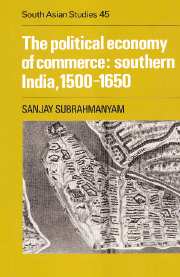Book contents
- Frontmatter
- Contents
- List of illustrations
- List of tables
- Preface
- Abbreviations used
- Introduction
- 1 The political economy of southern India, 1500–1650: preliminary remarks
- 2 Coastal trade and overland trade: complementarities and contradictions
- 3 Overseas trade, 1500–1570: traders, ports and networks
- 4 Overseas trade, 1570–1650: expansion and realignment
- 5 Europeans and Asians in an age of contained conflict
- 6 External commerce and political participation
- 7 Situating trade: models and methodological strategies
- Conclusion
- A note on currency and weights
- Glossary
- Note on sources
- Bibliography
- Index
- CAMBRIDGE SOUTH ASIAN STUDIES
5 - Europeans and Asians in an age of contained conflict
Published online by Cambridge University Press: 13 January 2010
- Frontmatter
- Contents
- List of illustrations
- List of tables
- Preface
- Abbreviations used
- Introduction
- 1 The political economy of southern India, 1500–1650: preliminary remarks
- 2 Coastal trade and overland trade: complementarities and contradictions
- 3 Overseas trade, 1500–1570: traders, ports and networks
- 4 Overseas trade, 1570–1650: expansion and realignment
- 5 Europeans and Asians in an age of contained conflict
- 6 External commerce and political participation
- 7 Situating trade: models and methodological strategies
- Conclusion
- A note on currency and weights
- Glossary
- Note on sources
- Bibliography
- Index
- CAMBRIDGE SOUTH ASIAN STUDIES
Summary
Writing some two decades ago, the American historian Holden Furber brought into currency an important concept, which has since repeatedly been used to characterise the interaction between Europeans and Asians (and in particular Indians) in the period from roughly 1500 to 1750. This was the term ‘the Age of Partnership’, and Furber argued that, far from being a period in which Europeans carefully and inexorably moved to conquer and subjugate Asia and its inhabitants, the early modern epoch had been witness to important forms of cooperation between Europeans and Asians. This view was counterposed, naturally, to writers of the school of K.M. Panikkar, whose view of a colonial age with roots from the very moment the degredados from Vasco da Gama's fleet set foot in Calicut has already been noted. However, as Ashin Das Gupta has recently pointed out, this conception of an age of partnership, in which violence was somehow incidental, was one viewed sceptically from the very outset by at least some, including Charles Boxer. More recently, Das Gupta himself has suggested a somewhat modified notion of ‘partnership’, one in which there was ‘the acceptance of a structure of trade and politics within which everybody functioned’ rather than ‘unreserved human acceptance of each other’.
There are broadly speaking two possible approaches to the question of the interface between Europeans and Asians in this age. There is firstly the approach which seeks to identify the facts of the matter, measuring in some terms the impact of the European presence on Asian traders in this or that region.
- Type
- Chapter
- Information
- The Political Economy of Commerce: Southern India 1500–1650 , pp. 252 - 297Publisher: Cambridge University PressPrint publication year: 1990
- 1
- Cited by



